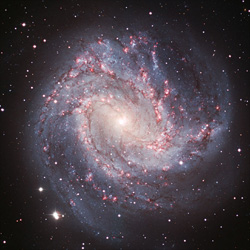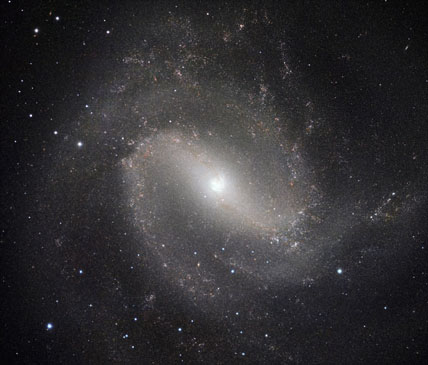These evenings northern skywatchers find the constellation Hydra, the Water Serpent, sprawled along the horizon from southwest to southeast and beyond. Although it's the largest constellation in area — totaling more than 1,300 square degrees! — Hydra holds relatively few deep-sky objects of interest to amateur astronomers.

M83 is a barred spiral galaxy, likely similar in structure to our own Milky Way. Knots of red hydrogen-alpha light mark star-forming regions in this visible-light view. Click here for a larger view.
ESO
The one great is exception is Messier 83, a magnificent barred spiral galaxy some 15 million light-years distant. M83 presents itself nearly face-on to us, revealing a gorgeous whorl of arms accentuated with dark veins of dust and hundreds of crimson star-forming regions. Known as the Southern Pinwheel, it's bright enough (total magnitude: 7.6) and big enough (12 arcseconds across) to be spotted easily in a small telescope.
M83 is often cited as a close match to how our own Milky Way might appear from afar — though it's only half as big, about 40,000 light-years across. The Southern Pinwheel has one other interesting claim to fame: it's had six supernovae in the last 100 years.
Unfortunately, M83's declination of –30° keeps it low down in the atmospheric murk for most northern observers — but not so for those of you in the Southern Hemisphere. Nearly two years ago the European Southern Observatory released a gorgeous portrait of M83 taken from La Silla Observatory in Chile.

Messier 83, the Southern Pinwheel galaxy, as captured in infrared light by the Very Large Telescope in Chile. Click here for a larger view.
ESO / M. Gieles
Now astronomers led by Mark Gieles (University of Cambridge) and Yuri Beletsky (ESO) have followed up with an infrared-only view of M83, seen above. It was taken with the High-Acuity Wide-field K-band Imager (HAWK-I) attached to one of the 8-meter-wide eyes of the Very Large Telescope atop Cerro Paranal in Chile. The three-wavelength composite required a total exposure of 8½ hours (more than 500 exposures of 1 minute each). Mischa Schirmer (University of Bonn) performed the challenging task of piecing all those frames together.
When viewed in the infrared, most of M83's obscuring dust becomes transparent and the light from its star-forming regions becomes muted. So researchers are better able to trace out the galaxy's structure and to reveal clusters of young stars that would otherwise be masked by cocoons of dust.
Be sure to check out this 45-second video, which fades back and forth between the visible-light and infrared views.
 2
2
Comments
Evan James
May 26, 2010 at 2:33 pm
Never heard of this galaxy. looks like a cool target though. Can you see it from Florida?????
You must be logged in to post a comment.
John Mahony
June 2, 2010 at 6:14 pm
"Known as the Southern Pinwheel, it's bright enough (total magnitude: 7.6) and big enough (12 arcseconds across) to be spotted easily in a small telescope."
That's 12 arcminutes, not seconds.
@Evan James: The messier objects were discovered (or at least confirmed) by Messier, usually observing from Paris (before modern light pollution, of course!), so they are all visible from mid-northern latitudes.
But face-on galaxies tend to have low surface brightness, and this object will be fairly low in the south (but maybe not that low from Florida), so the horizon haze will also affect it.
You must be logged in to post a comment.
You must be logged in to post a comment.